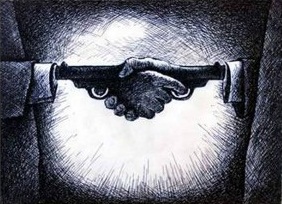<Back to Index>
- Writer Publius Flavius Vegetius Renatus, 5th Century
PAGE SPONSOR


Publius Flavius Vegetius Renatus, commonly referred to simply as Vegetius, was a writer of the Later Roman Empire. Nothing is known of his life or station beyond what he tells us in his two surviving works: Epitoma rei militaris (also referred to as De Re Militari), and the lesser known Digesta Artis Mulomedicinae, a guide to veterinary medicine.
The latest event alluded to in his Epitoma rei militaris is the death of the Emperor Gratian (383); the earliest attestation of this work is a subscriptio by one Flavius Eutropius, writing in Constantinople in the year 450, which
appears in one of two families of manuscripts, suggesting that a
bifurcation of the manuscript tradition had already occurred. Despite
Eutropius' location in Constantinople, the scholarly consensus is that
Vegetius wrote in the Western Empire. Vegetius dedicates his work to the
reigning emperor, who is identified as Theodosius, ad Theodosium imperatorem, in the manuscript family that was not edited in 450; the identity is disputed: some scholars identify him with Theodosius the Great, while others follow Otto Seeck and identify him with the later Valentinian III, dating the work 430-35.
Vegetius' epitome mainly focuses on military organization and how to react to certain occasions in war. Vegetius explains how one should fortify and organize a camp, how to train troops, how to handle undisciplined troops, how to handle a battle engagement, how to march, formation gauge, and many other useful methods of promoting organization and valor in the legion.
As G.R. Watson observes, Vegetius' Epitoma "is the only ancient manual of Roman military institutions to have survived intact." Despite this, Watson is dubious of its value, for he "was neither a historian nor a soldier: his work is a compilation carelessly constructed from material of all ages, a congeries of inconsistencies." These antiquarian sources, according to his own statement, were Cato the Elder, Cornelius Celsus, Frontinus, Paternus and the imperial constitutions of Augustus, Trajan, and Hadrian.
The first book is a plea for army reform; it vividly portrays the military decadence of the Late Roman Empire. Vegetius also describes in detail the organization training and equipment of the army of the early Empire. The third contains a series of military maxims, which were (rightly enough, considering the similarity in the military conditions of the two ages) the foundation of military learning for every European commander from William the Silent to Frederick the Great.
His book on siegecraft contains the best description of Late Empire and Medieval siege machines. Among other things, it shows details of the siege engine called the onager, which afterwards played a great part in sieges, until the development of modern cannonry. The fifth book is an account of the materiel and personnel of the Roman navy.
The author of the 1911 Encyclopaedia Britannica article states that "In manuscript, Vegetius' work had a great vogue from its first advent. Its rules of siegecraft were much studied in the Middle Ages." N.P. Milner observes that it was "one of the most popular Latin technical works from Antiquity, rivalling the elder Pliny's Natural History in the number of surviving copies dating from before AD 1300." It was translated into English, French (by Jean de Meun and others), Italian (by the Florentine judge Bono Giamboni and others), Catalan, Spanish, Czech, and Yiddish before the invention of printing. The first printed editions are ascribed to Utrecht (1473), Cologne (1476), Paris (1478), Rome (in Veteres de re mil. scriptores, 1487), and Pisa (1488). A German translation by Ludwig Hohenwang appeared at Ulm in 1475.
However, from that point Vegetius' position as the premier military authority began to decline, as ancient historians such as Polybius became available. Niccolò Machiavelli attempted to address Vegetius' defects in his L'arte della Guerra (Florence, 1521), with heavy use of Polybius, Frontinus and Livy, but Justus Lipsius' accusation that he confused the institutions of diverse periods of the Roman Empire and G. Stewechius' opinion that the survival of Vegetius' work led to the loss of his named sources were more typical of the late Renaissance. While as late as the 18th century a soldier such as Marshal Puysegur based his own works on this acknowledged model, in Milner's words, Vegetius' work suffered "a long period of deepening neglect".
Vegetius
is keen to stress the shortcomings of the Roman Army in his lifetime.
In order to do this he eulogizes the Army of the early Empire. In
particular he stresses the high standard of the legionaries and the
excellence of the training and the officer corps. In reality, Vegetius
probably describes an ideal rather than the reality. The Army of the
early Empire was a formidable fighting force but it probably was not in
its entirety quite as good as Vegetius describes. In particular, the
five foot ten inches minimum height limit identified by Vegetius would
have excluded the vast majority of the working classes in Roman times,
except for the fact that the Roman foot was less than the English foot,
at 11.65 inches; hence, 5'10" Roman is 5' 7.5" in modern terms,
which is just above average height of Roman (Italian) men of the time
from skeletal evidence. The emperor Valentinian (364 - 375) lowered the
height limit to 5' 7" Roman which equals 5.5 inches. Despite the
romanticism extolling the idealized virtues of the Roman Legion of an
earlier time, Vegetius' De Re Militari remains a reliable and useful
insight into the success of the early Roman Empire.
N.P. Milner notes, "that it was the same Vegetius who wrote both works was proved through close verbal and stylistic parallels by C. Schoener, and is generally accepted."
The eminent Sir William Smith took the opposite view in his dictionary (17th edition, 1881), where he says "his [author of D.A.M.] date is uncertain, but was long subsequent to that of [our author].". The Lewis & Short dictionary expresses the same view, giving the D.A.M author's date as about 420.